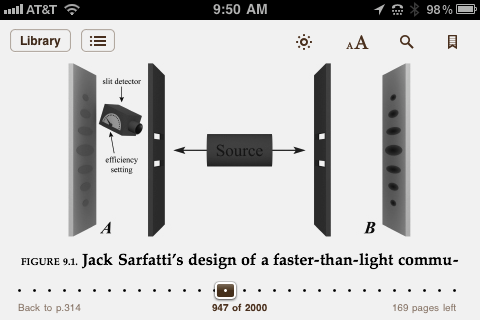On Sep 21, 2011, at 6:24 PM,
I took a brief look before (I'll look more later) and remember that you get a total probability of > 1.
Right
You deduce from this a breakdown of the Born rule
Right
and show an observable may be modulated across an entangled state. Is that right?
I don't show it explicitly, but I am quite sure it can be modulated in several different ways - will show it explicitly soon in more than one way.
The key points that are the reasons the no-entanglement signaling theorem works in all its variations are:
1) the orthogonality of the base states of the sender.
2) the fact that any unitary change of base states will not change the orthogonality property
3) the overcomplete Glauber base states are non-orthogonal.
4) Therefore, there is no unitary change of base states that will map sharp number Fock base states to minimum uncertainty wave-packets in number and phase Glauber base states. (Similarly for squeezed variations on the Glauber coherent states).
This is the essence of P.W. Anderson's "More is different" Higgs-Goldstone spontaneous symmetry breakdown of the ground state of complex systems in an emergent phase transition to Bohm's new orders of wholeness. In terms of Feynman diagrams you need to sum an infinity of them of a special class to get the ODLRO macroscopic eigenvalue of a single particle or single pair state.
I don't know if you made any errors,
One can force my probabilities to add to one by ad-hoc renormalization, but that is a new rule assuming what needs to be tested empirically. Basically, an experiment needs to be done.
but it seems to me that if you are correct and you derive a violation of the Born rule without adding anything new to orthodox QM, it shows there must a fundamental inconsistency within orthodox QM (i.e., Born rule cannot be postulated as a condition of the theory).
Right. However, the new element is spontaneous symmetry breaking emergence of new higher level order - a non-unitary process with c-number signal order parameters added on to the q-number quantum fields. It's the "phase rigidity" absent in micro-quantum theory that is the new physics analogous to non-zero curvature distinguishing General Relativity from Special Relativity. All the S-Matrix experiments in the LHC for example are done with simple particle beams - not with coherent beams.
On the other hand, we know Bohm's theory adds something new (an event description) and is manifestly not restricted by the Born rule. Just my thoughts. I would like to discuss more in Orlando.
What I am talking about in Bohm's informal language is a direct back-reaction of the Bohm hidden variable "particle" on its piloting Quantum Potential that is absent in orthodox micro-quantum theory.
I am predicting that specially-designed entangled Glauber pair states can be made such that my old idea Fig 9.1 of Kaiser's book will work.

Of course if you use the kinds of entangled states that Anton Zeilinger uses in Vienna etc. there are no nonlocal signals there, and the uncontrollable quantum randomness of incoherent individual events (no ODLRO in the low-order density matrices) will protect them as the no-cloning theorem asserts. However, if Zielinger is not careful with his laser sources he may permit Eve to hack in.
In a message dated 9/21/2011 9:00:38 P.M. Eastern Daylight Time,
Just study my equations in the last part of this paper. It's ALL there in the mathematics INDEPENDENT of the informal language interpretation, Bohm, Copenhagen, Many Worlds, Transaction etc makes no difference
of course I may have made an error?
listen also to hour 2 of Sept 18, 2011 Coast to Coast Radio http://vaca.bayradio.com/ksfo_archives/10000.mp3 (only good for a few days)
On Sep 21, 2011, at 5:54 PM,
Hi Jack,
Regarding the light-speed signal barrier, I'm glad your bringing this issue to the table. As we talked about I think Bohm's theory provides the formalism to break the barrier because Bohm's theory is an "individual event" description.
I think we agree, but correct me if I'm wrong. Doesn't the light-speed signal barrier theorem in orthodox QM depend on there not being an "event" description (i.e., QM has a built-in and unavoidable randomness)? Without this "built-in" randomness the light-speed signal barrier theorem breaks down.
Gerry
